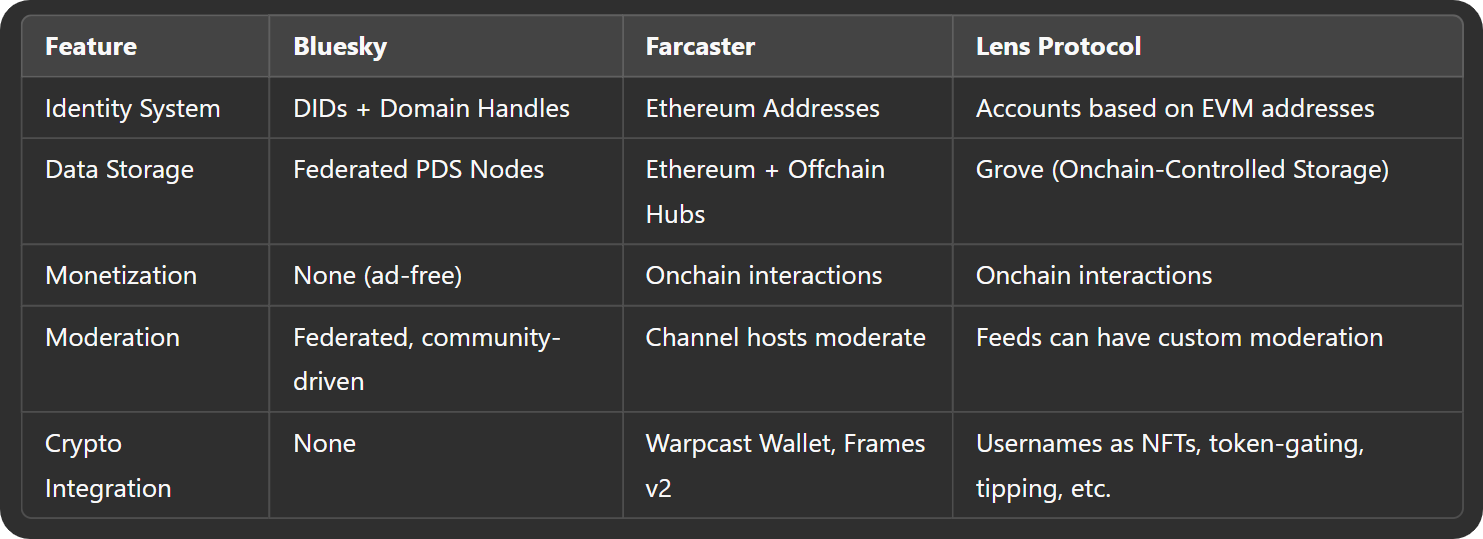Exploring Bluesky: A Non-Crypto, User-Controlled X Alternative

These days, X (formerly Twitter) can sometime feel more like Elon Musk's personal fiefdom than a decentralized global town square for open discussions.
Despite early hopes for free speech absolutism, political dissidents are still being censored. Low-credibility content is algorithmically boosted. Links to outside platforms kill your engagement. And the ability of users to curate their own experience with blocks has been defanged. And while these things may help Musk run X as a business, the collective dynamic is pushing more people to look elsewhere for their microblogging kick.
But while decentralized social networks like Farcaster and Lens have gained some traction, many even in the crypto industry are hesitant to leave X behind. Meanwhile, other explicitly non-financial decentralized social media options like Bluesky are seeing uptake.
Bluesky uses cryptography, not crypto tokens, but its main thrust is similar to Farcaster and Lens in that it emphasizes user control and portable identity. It's been garnering a strong following on the political left amid sustained backlash to X owner Elon Musk's role in the Trump administration, and just this week Barack Obama joined the decentralized network where he now has some 311K followers.
There's no token airdrop opportunity here, but let's catch you up on how Bluesky works and what sets it apart in X's Elon era 👇
How Bluesky's protocol works
In 2019, Twitter CEO Jack Dorsey kicked off a decentralization initiative. The idea? Create an open, decentralized social media standard that Twitter could eventually adopt.
Bluesky was born out of that research effort, and it has since spun out and evolved into an independent public benefit corporation led by Jay Graber, previously a developer for Zcash.
Bluesky CEO Jay Graber details how the platform utilizes open networks to allow users to craft their own social media experience while maintaining their personal privacy. pic.twitter.com/U9gh7gw1tG
— SXSW (@sxsw) March 10, 2025
Bluesky runs on the Authenticated Transfer (AT) Protocol, its bespoke open-source framework that prioritizes user autonomy, portability, and cryptographic verification. The key elements here include:
- 🪪 Federated Identity — Users maintain a single portable identity across different apps and servers via decentralized identifiers (DIDs). Unlike X, where your account is locked to the platform, Bluesky lets you move between servers while keeping your handle, social graph, and posts intact.
- 📱 Custom Feeds — Instead of one monolithic algorithm determining what you see, Bluesky allows user-created algorithmic feeds, meaning you control what shows up in your timeline.
- 📂 Decentralized Data Storage — Posts and content are stored on Personal Data Servers (PDSs), which users can self-host or rely on independent providers, ensuring resilience against unilateral bans.
- 🚿 Relays and Firehose — Bluesky’s relays aggregate network-wide data and distribute it to different applications, maintaining an open data layer for third-party developers.
This overall design ensures that no single entity—corporate or individual—can dictate the rules of the platform, a stark contrast to Musk's current centralized control of X.
We are trying to do our part by funding an initiative around an open decentralized standard for social media. Our goal is to be a client of that standard for the public conversation layer of the internet. We call it @bluesky: https://t.co/51or6OuNNv
— jack (@jack) January 14, 2021
How Bluesky compares to other platforms
Bluesky vs. X
Bluesky distinguishes itself from X in several major ways:

Accordingly, Bluesky aims to “billionaire-proof” social media by removing the ability for a single entity to control the entire network—a direct response to Musk’s X, where policy changes happen on a whim.
Bluesky vs. onchain social
Bluesky’s n0-crypto stance sets it apart from decentralized networks that integrate financialization, like Farcaster and Lens:

There are some broad similarities here, of course, like customizable moderation, decentralized identity, and distributed data. But Bluesky stands out from these cousins in explicitly eschewing native support for coins, tokens, etc.
What Bluesky has planned
Last year, Bluesky added features like direct messages, video sharing, and hashtags. Bluesky’s next phase is focused on scaling up while staying decentralized.
According to the project's 2025 roadmap, the team is improving how data moves across the network, making relays more efficient and reducing server costs. They’re also rolling out new OAuth permissions, giving users better control over which apps can access their data.
Another big update coming soon is private and encrypted data, allowing for invite-only discussions and secure direct messages. To make Bluesky feel less tied to its main instance, they’re also building a more open signup system, so users can easily join from different servers.
These changes aim to make Bluesky more private, more flexible, and more independent, reinforcing its vision of a user-owned social network that can’t be domineered by a single entity.
How to get started
Interested in trying Bluesky? It's simple to sign up and start exploring:
- 🦋 Create an Account — Visit bsky.app or download the Bluesky app for iOS or Android. Sign up with an email, create a username, and set a password.
- 🆔 Set Your Handle — By default, your username will end in bsky.social, but you can also prep a custom domain if you want a more personalized identity.
- 🧑💻️ Find Feeds + People to Follow — Tap the "Feeds" button to explore and follow feeds that match your interests. You can also use Starter Packs to quickly follow recommended accounts.
- 🧱 Customize Your Experience — Head to "Settings" to tweak your moderation preferences, enable or disable certain types of content, and adjust your feed visibility.
- 📣 Engage with the Community — Post, comment, like, and repost to join the conversation. Use hashtags to connect with like-minded users, and check out third-party apps like SkyFeed for a different browsing experience.
Zooming out, Bluesky is still small compared to X, but it has seen rapid growth over the last year. And with its decentralized approach and customizable feeds, it’s certainly a refreshing alternative to consider for anyone wanting more control over their social media. Let's see how it fares going forward!
— bluesky (@bluesky) March 10, 2025